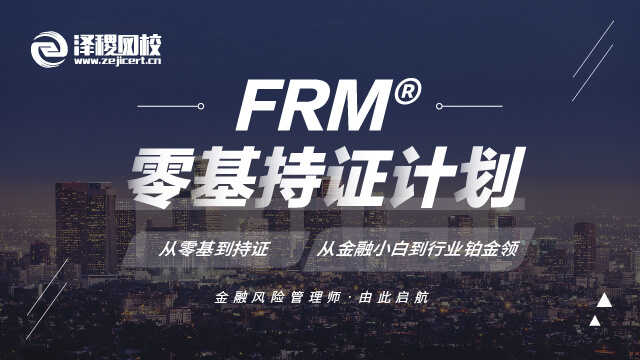
目前2020年FRM一级考纲已经出炉了,不知道同学们有没有了解过呢?如果你打算报考2020年FRM考试的话可一定要做好这方面的功课哦,毕竟新的考纲对于我们同学的备考也是有着很重要的作用的,下面泽稷小编就先来为大家介绍一下FRM一级考纲的状况吧!
一、Foundations of Risk Management
1.考试比重
占比20%,较往年比并没有改变。
2.FRM®教材变化和考点解读
综述
今年GARP协会重新编写了相关参考书,所以之前的参考书目作废。新编教材中的章节内容如下。
Chapter 1.The Building Blocks of Risk Management
Chapter 2.How Do Firms Manage Financial Risk?
Chapter 3.The Governance of Risk Management
Chapter 4.Credit Risk Transfer Mechanisms
Chapter 5.Modern Portfolio Theory(MPT)and the Capital Asset Pricing Model(CAPM)
Chapter 6.The Arbitrage Pricing Theory and Multifactor Models of Risk and Return
Chapter 7.Principles for Effective Data Aggregation and Risk Reporting
Chapter 8.Enterprise Risk Management and Future Trends
Chapter 9.Learning from Financial Disasters
Chapter 10.Anatomy of the Great Financial Crisis
Chapter 11.GARP Code of Conduct
解读
第1章和第2章探讨了不同的风险类型,风险是如何在一个组织中产生的,以及如何管理金融风险。
第3章描述了公司治理在风险管理中的作用,包括董事会的作用和组织的其他领域。本章还介绍了风险偏好的概念以及如何将其转化为风险偏好框架并在整个组织内进行沟通。
第4章概述了信用衍生品和证券化等信用风险转移机制,并讨论了次级抵押贷款证券化的相关问题。
第5章介绍了现代投资组合理论(MPT)和资本资产定价模型(CAPM),这是风险调整定价和估值的基础。
接下来的第6章,介绍了套利定价理论(APT)模型是如何被用来建模并获取资产的回报。数据是许多大型金融组织的命脉,汇总和报告风险数据变得越来越重要。
第7章讨论了这个重要的主题。
第8章介绍了企业风险管理(ERM),这是一种在组织环境中评估和管理风险的常见而重要的方法,并讨论了它的未来趋势。
从历史经验中学习也是很重要的,第9章描述了过去的各种金融灾难。
第10章重点介绍了2007-2009年的金融危机。
为了确保风险管理行业的道德标准得到维护,第11章论述了GARP的行为准则,所有会员都必须遵守该准则。
变化
较之过往教材,今年FRM®教材每一个章节的名字都做了变动(有且只有Chapter 11.GARP Code of Conduct.的名称以及考纲内容没有变动)。事实上,不仅章节名字和过去不一样,每一章的具体内容也发生了巨大的变化,章节之间的内容重新做了整合,也新增了很多内容,比如第4章就是本次教材改写后新增的。
即便那些沿用了过去教材主体框架的章节,具体阐述的内容也不尽相同,有些公式指标的具体名称发生了变化(比如代表特雷诺指标的TPI);有些金融案例的侧重点发生了改变。
此外,一些原本属于二级才会接触到的相关知识(比如RAROC公式,比如TIER1,TIER2之类的概念)现在也下放到了本门的学科中。
3.学科点评
鉴于此,2020版一级风险基础管理的考纲其实就是一份针对新编教材的新版考纲,并不算是对往年版本的修订和补充。因为和之前的考钢相比,他们之间重叠的部分不多。所以大家只用关注新教材新考纲本身即可。
对于这门学科,大家一定要给予足够的重视,参加明年考试的同学务必购买最新版本的教材,切莫使用往年的教材备考。
二、Quantitative Analysis
1.考试比重
占比20%,和去年相比没有变化。
2.教材变化和考点解读
2020年数量这门学科结构上有很大改变,知识点和以前相似度很高,有部分增加和删减。
今年GARP协会重新编写了教材,新编教材中的章节内容如下。
•Chapter 1.Fundamentals of Probability
•Chapter 2.Random Variables
•Chapter 3.Common Univariate Random Variables
•Chapter 4.Multivariate Random Variables
•Chapter 5.Sample Moments
•Chapter 6.Hypothesis Testing
•Chapter 7.Linear Regression
•Chapter 8.Regression with Multiple Explanatory Variables
•Chapter 9.Regression Diagnostics
•Chapter 10.Stationary Time Series
•Chapter 11.Nonstationary Time Series
•Chapter 12.Measuring Returns,Volatility and Correlation
•Chapter 13.Simulation and Bootstrapping
数量总体可以分为三个部分。
✅第一部分Probability&Statistics(Chapter 1-Chapter 6)
知识点和以前相似,新增部分知识点:
•新增Describe an event and an event space.
•新增Define and calculate a conditional probability.
•新增Characterize the quantile function and quantile-based estimators.
•新增interquartile range.
•新增Law of large numbers.
✅第二部分Linear Regression(Chapter 7-Chapter 11)
前三个Chapter分别讲了回归的基本知识,一元回归,多元回归和回归中容易遇到的问题。后两个Chapter为time series。知识点和以前相似。
第三部分simulation,volatilities and correlation(Chapter 12-Chapter 13)
Simulation部分变化不大,仍是Monte Carlo simulation,bootstrapping和pseudo-random number generation。
Copulas整章删除。
Volatility部分变化也很大。删除EWMA,GARCH和volatility term structure相关内容。
新增部分内容:
•Calculate,distinguish and convert between simple and continuously compounded returns.
•Describe how the first two moments may be insufficient to describe non-normal distributions.
•Explain how the Jarque-Bera test is used to determine whether returns are normally distributed.
•Define correlation and covariance and differentiate between correlation and dependence.
•Describe properties of correlations between normally distributed variables when using a one-factor model.
3.学科点评
2020年数量这门课结构上有很大改变,知识点与以前重合度很高,但是仍有很多新增和删减的内容。学科占比不变,但是数量是其他学科的基础,同学们在学习的时候要给与足够的重视。【FRM电子版备考学习资料】

三、Financial Markets and Products
1.考试比重
占比30%,和去年相比没有变化。
2.教材变化和考点解读
•Chapter 1.Banks
•Chapter 2.Insurance Companies and Pension Plans
•Chapter 3.Fund Management
•Chapter 4.Introduction to Derivatives
•Chapter 5.Exchanges and OTC Markets
•Chapter 6.Central Clearing
•Chapter 7.Futures Markets
•Chapter 8.Using Futures for Hedging
•Chapter 9.Foreign Exchange Markets
•Chapter 10.Pricing Financial Forwards and Futures
•Chapter 11.Commodity Forwards and Futures
•Chapter 12.Options Markets
•Chapter 13.Properties of Options
•Chapter 14.Trading Strategies
•Chapter 15.Exotic Options
•Chapter 16.Properties of Interest Rates
•Chapter 17.Corporate Bonds
•Chapter 18.Mortgages and Mortgage-Backed Securities
•Chapter 19.Interest Rate Futures
•Chapter 20.Swaps
✅Chapter 1-3提供了金融市场的背景介绍,分别介绍了银行,保险和基金。Chapter 1介绍了商业和投资银行业务的结构,银行的监管方式,风险的性质,资本在提供缓冲损失方面的作用以及证券化MBS的处理。
新增了Summarize Basel Committee regulations for regulatory capital and their motivations.
Chapter 2介绍了保险公司所面临的风险和法规,资本要求和绩效比率,以及养老金的类型和主要特征。Chapter 3介绍了各种基金的基本知识。
✅Chapter 4-9介绍了金融市场的衍生品。
Chapter 4介绍了options,forwards,and futures,以及衍生品市场和市场参与者所面临的风险。Chapter 5描述了交易所交易和场外交易市场。Chapter 6探讨了CCPs,以及CCPs面临的风险类型。Chapter 7-8介绍了期货市场以及如何将期货用于对冲。Chapter 9介绍了外汇市场,估算外汇风险的方法,使用期权的多货币对冲策略,以及利率平价公式。
✅Chapter 10-15更加深入仔细的讨论了各种衍生品。
Chapter 10-11具体介绍了forwards和futures,包括他们的定价和确定commodity forwards和futures的无套利价值。Chapter 12-15具体介绍了options及其在风险管理中的用途,包括不同options的特征,市场机制,多期权和对冲策略以及exotic options。
✅Chapter 16-18讨论了利率和两类重要的固定收益证券。
Chapter 16介绍了利率的性质,并解释了债券的估值,期限和凸度,以及远期利率协议的定价以及期限结构的理论。这一章去年是放在forward和futures定价之前讲到的,今年换了顺序挪到了后面。Chapter 17介绍公司债券,类型,特征,以及信用等级。Chapter 18讲了mortgages,解释MBS pools,以及mortgage pool metrics的预付款建模和计算。这两章的内容我们会在Valuation那门课中进行讲解。
✅Chapter 19-20探讨了两个衍生工具:interest rate futures和swaps。
Chapter 19介绍了利率和国债与futures和forward prices的关系,并讨论了在对冲中使用interest rate futures。Chapter 20描述了swaps的机制,类型和定价。这两章去年是在前面介绍option之前讲到的,今年把顺序挪到了最后。
3.学科点评
2020年金融市场这门课因为重新编写了教材,结构顺序上有很大改变。很多章节的考纲要求发生了改变,但是知识点与以前是相似的。由于有很多知识点细节的新增和删减,同学们在学习的时候要给与足够的重视。
四、Valuation and risk models
1.考试比重
该学科在一级考试中的占比仍然为30%,依然是一级考试的重点学科。内容上,有少量的新增和调整。
2.教材变化和考点解读
新增
Chapter 2.Calculating and Applying VaR
Describe and explain the historical simulation approach for computing VaR and ES
Chapter 3.Measuring and Monitoring Volatility
Apply the exponentially weighted moving average(EWMA)approach and the GARCH(1,1)model to estimate volatility.
Explain and apply approaches to estimate long horizon volatility/VaR and describe the process of mean reversion according to a GARCH(1,1)model.
Describe an example of updating correlation estimates.
Chapter 4.External and Internal Credit Ratings
Define and use the hazard rate to calculate unconditional default probability of a credit asset.
Define recovery rate and calculate the expected loss from a loan.
Describe alternative methods to credit ratings produced by rating agencies.
Explain historical failures and potential challenges to the use of credit ratings in making investment decisions.
Chapter 6.Measuring Credit Risk
Describe the Gaussian copula model and its application.
Describe and apply the Vasicek model to estimate default rate and credit risk capital for a bank.
Describe the CreditMetrics model and explain how it is applied in estimating economic capital.
Chapter 10.Interest Rates
Describe overnight indexed swap(OIS)and distinguish OIS rates from LIBOR swap rates.
删减
Chapter 4.External and Internal Credit Ratings
Describe the process for and issues with building,calibrating,and backtesting an internal rating system.
Identify and describe the biases that may affect a rating system.
替换
Chapter 5.Country Risk:Determinants,Measures,and Implications
Describe characteristics of sovereign credit spreads and sovereign credit default swap(CDS)and compare the use of sovereign spreads to credit ratings.(2020)
Describe the advantages and disadvantages of using the sovereign default spread as a predictor of defaults.(2019)
Chapter 7.Operational Risk
Describe the different categories of operational risk and explain how each type of risk can arise.Compare the basic indicator approach,the standardized approach and the advanced measurement approach for calculating operational risk regulatory capital.(2020)
Describe the standardized measurement approach and explain the reasons for its introduction by the Basel committee.(2020)
Compare three approaches for calculating regulatory capital.(2019)
Describe the Basel Committee’s seven categories of operational risk.(2019)
3.学科点评
从章节名称上看,估值这门课没有太大的变化,个别章节的内容上略微有所增减。总体来说,新增的知识点,Chapter 2新增知识点原属于二级市场风险,Chapter 6新增知识点也将原先二级的知识整合到了这门课中,加深了这门课的难度。
Chapter 3将原来一级数量中的EWMA和GARCH模型移到了估值这门课,使得模型和实际运用更为贴切。
Chapter 10在原先各大利率的基础上增加了对OIS和LIBOR的扩充,使得整个利率体系更加完整。LOS替换部分,没有较大的实质性变化。虽然协会替换了参考书目,但总体来说影响不大,因为主要涉及的考点并没有发生过多变化,重点章节无过多改变。
以上就是本次泽稷小编为诶同学们带来的全部信息了=,大家如果还有什么疑问的话也都可以通过我们泽稷网校的官网进行查询哦,小编也会经常为同学们分享一些考试资讯的。
相关资讯:
扫码咨询泽稷老师,解读CFA®考试政策变动,海量CFA®学习资料免费领取,提供在线解答CFA®学习疑惑。





 白金级认可培训资质(总部)
白金级认可培训资质(总部)
 课程试听
课程试听
 职业规划
职业规划
 ACCA中文教材
ACCA中文教材
 考位预约
考位预约
 免费资料
免费资料




 题库下载
题库下载
 模拟机考
模拟机考




 CFA®成绩查询
CFA®成绩查询




 GARP协会官方认可FRM®备考机构
GARP协会官方认可FRM®备考机构




















